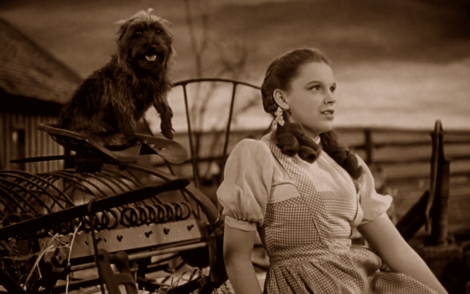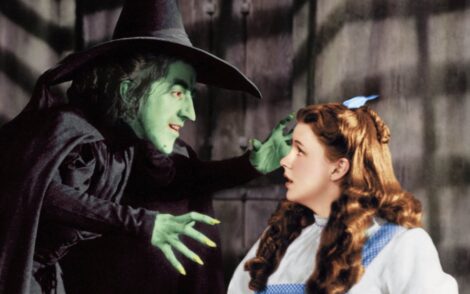The Wizard of Oz
Front Row at the Movies by Shirrel Rhoades
[mr_rating_result]Yesterday I was talking with my old colleague Michael Patrick Hearn, author of “The Annotated Wizard of Oz,” a compendium of facts about L. Frank Baum’s book about a girl from Kansas who travels to the mythical Land of Oz.
Baum’s book was the basis for the classic MGM movie, “The Wizard of Oz.”
“When it wrapped in 1939, The Wizard of Oz was one of the most expensive movies ever made,” reported The Washington Post. “The movie … used 9,200 actors, 30 sound stages on the MGM lot, and 65 sets. The production required so much electricity to run the lights for the Technicolor film that a fire marshal stood by to make sure rising temperatures on set wouldn’t spark the thatched roofs of Munchkinland into flames.
 “While the rest of the country crawled its way out of the Great Depression, MGM spent $3 million on creating the fictional world of Oz.”
“While the rest of the country crawled its way out of the Great Depression, MGM spent $3 million on creating the fictional world of Oz.”
Few films have enjoyed the cult status and enduring popularity of this American musical fantasy, my friend Michael points out. It is considered one of the greatest cinema masterpieces in history.
However, when it came to creating the movie, everything wasn’t rainbows and poppy fields. The makeup made the actors sick.
Originally cast as the Tin Man, Buddy Ebsen suffered a violent reaction to the aluminum paint, winding up in the hospital. MGM was forced to recast his part to Jack Haley.
Ray Bolger’s Scarecrow burlap-simulated prosthetics left marks on his skin that didn’t disappear for more than a year after the filming wrapped up.
Bert Lahr’s Cowardly Lion costume made him sweat so heavily that it took two assistants to dry it out every night.
Judy Garland’s costume was so tight (to hide her budding boobies) she could hardly breath. And according to future husband Sid Luft, the Munchkins “would make Judy’s life miserable on set by putting their hands under her dress ….”
“The Wizard of Oz” cost the equivalent of $55 million to make, but the movie was only a modest success when first released. It didn’t turn a profit until it was re-released in 1947.
Some Hollywood wags claim that Judy Garland was only paid “$35 a week while the dog who played Toto earned $125 a week.” However, this is just an urban legend.
Garland’s salary was closer to $500 per week.
Scarecrow Ray Bolger and Tin Man Jack Haley were each making around $3,000 per week, and Cowardly Lion Bert Lahr wasn’t far behind them at $2,500 per week.
Each of the 124 Munchkins who appeared in the movie received $50 per week.
 Yes, in the book, Dorothy’s ruby-red slippers were actually silver. The change was made because MGM studio head Louis B. Meyer wanted to show off the new technicolor better.
Yes, in the book, Dorothy’s ruby-red slippers were actually silver. The change was made because MGM studio head Louis B. Meyer wanted to show off the new technicolor better.
Last year, I actually went to the Land of Oz, but it wasn’t in Kansas. There’s a former amusement park located on Beech Mountain in Western North Carolina. At one time more than 300,000 visitors skipped down the Yellow Brick Road, reliving the adventures of Dorothy Gale and her little dog Toto on their way to the Emerald City. Back in the ‘70s, Land of Oz was ranked as the second most visited tourist park in the eastern United States, behind Disney World.
Sadly, it closed in 1980.
Land of Oz was never really a true amusement park. There was only one ride, a ski lift pretending to be a hot air balloon. And today it doesn’t even have that. A visit is more like a feeble family reunion than a visit to, say, Disneyland.
But for Wizard of Oz fans – known as Ozzies – the defunct park re-opens on Fridays in June for “Journey with Dorothy Tours” and in September for “Autumn at Oz,” the largest Wizard of Oz festival in the country.
“The Wizard of Oz” was always about a search: a winding journey toward figuring out something about yourself. Yes, Oz exists in our imagination – and on the silver screen. And you can go there for the price of a movie ticket.
Email Shirrel: srhoades@aol.com


Ratings & Comments
[mr_rating_form]